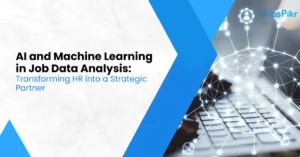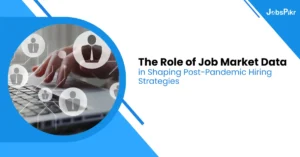Recruiting has been boosted by major technological innovations like process automation and Machine Learning. Recruiting candidates usually consists of multiple stages, starting from actually getting individuals to apply for the job that you have advertised, right up to having the person turn up on day 1.
The stages can be broken down into:
- Sourcing applicants.
- Aggregating the applicant data.
- Shortlisting Candidates.
- Interviews and reviews.
- Finalizing offers and negotiation.
- Onboarding.
Almost every stage mentioned above has taken advantage of the latest software and tools to reduce manual effort and the human errors that creep in along with it. Both time and effort required for the recruitment process are reduced when using the proper tools at every step.
Talent acquisition is usually done by posting jobs on websites like Indeed or LinkedIn. Sometimes they are even posted on social media websites like Facebook. The reach of your job post often depends on your budget. While the normal job listing may cost a certain amount, often sites allow you to also pay a premium to show your listing at the top as a sponsored and verified job post. These often attract more applicants and the top talent in the sector.
Candidates with matching profiles apply by themselves and send in their resumes using links, attachments in emails, or messages on any platform. Aggregating all the data from hundreds of candidates is done using resume parsing software. Once the data is extracted and stored in an easy-to-use format like CSV, or databases like DynamoDb or Postgres, automated job matching tools come into play. These use certain data points and information from candidates to find the ones that have the closest match to the job post that has been shared. Ranking algorithms are used to award a score to each candidate based on his or her suitability for the job profile.
In the next stage, interviews and reviews are also undertaken using websites like HackerRank or HackerEarth. These platforms help test the analytical abilities of candidates along with their problem-solving skills. Tech companies also take coding interviews via these websites. The latest AI-based software even analyses video interviews of candidates to mark them on different criteria such as confidence, readiness, knowledge levels, and more.
Offer finalization, negotiation, and onboarding may be the only few stages that are mostly through complete human contact, where Human Resource Personnel needs to show their convincing skills along with negotiating prowess to bag the right candidate at the right package. Thus we just saw how technology and tech tools influence every stage of the recruitment process directly or indirectly.
Traditional Job Searching Methods
The most critical issue with traditional job searching methods is the time that a lot of time is required and even then there’s no guarantee of finding job posts matching one’s profile. Browsing job posts on websites or newspapers is more or less the same if you need to read the requirements and compare each with your profile one by one. Here your chances of success would solely depend on how many job posts you can browse, and if you find any posts related to your field.
In case you are setting up a job board or a job website to help candidates find jobs, just aggregating jobs may not be enough, since individuals would still need to browse through hundreds of job posts to find the most appropriate ones. One may argue that filters can help reduce this effort to a certain extent, but even then, given the variety of profiles that are possible for a specific job position, it would still take your job seekers considerable manual effort to find their jobs.
How do Job Matching Tools Work?
Job Matching Tools work mainly with data– from job posts as well as candidate profiles. They use certain data points like:
- Position name
- Skills (such as software and tools that one is familiar with)
- Work experience
- Educational Qualifications
- Location
- Salary range
- Sector
These data points are extracted from the profile of candidates and matched with job posts. The matching cannot be a direct keyword match since this would highly reduce the accuracy of the matches. Instead, an AI-based machine learning system would be able to find similarities between a profile and a job post based on certain set parameters and threshold values.
The benefit of job feeds
Live Job Feeds can help a great deal in case you want to implement an automated job matching tool. The objective for this can be multiple– market-research, training ML models, developing new AI algorithms, or just offering value-added services to those who log in to your online job board.
A live feed can provide you with continuous data that can be fed into a job matching model. These models or tools can try matching the jobs to a list of candidates and their profiles. Re-enforced training of ML models can also be implemented if the data stream is frequently updated. This would help improve the accuracy of the algorithms to a great extent, over time.
Integrating a job feed into your current system may seem complicated at first, but it would just require a one-time setup. If the format of the job feed is pre-decided and doesn’t change, you can automatically consume the data and push it to the next module without the need for regular maintenance or updates.
Where does JobsPikr come into the picture?
As featured in a Forrester report, JobsPikr is the tool for you if you have a use case related to job data and require a customized job feed for your project. The live feed provided by this DaaS system helps you to obtain a customizable job feed and analytics solution. You are not only provided a feed of live data, but you also have the option to fetch historical data for any sector.
Historical data can be very important for those studying the job market. For instance, to understand the possible effect of the Coronavirus on jobs, scientists and economists studied similar historical events like the 2008 market crash and the effects that they had.
On the other hand, a live data stream of the latest jobs would be extremely important for job seekers so that they can always stay at the top of new job posts and be early applicants to most of the positions. An automated job-matching tool would enable this to a high degree since it could send alerts to subscribers whenever a job post with a high degree of match flows in through the live feed. Candidates can even set a threshold percentage to receive notifications for jobs that cross that match percentage.
The data is fetched for different sectors across multiple regions like the UK, the USA, the UAE, Australia, Canada, Singapore, and more. The feed itself is tailored based on the specifics provided by an individual client. It can be customized based on sector, location, job titles, or even company names. Apart from English, job posts in regional languages like Danish, French, and Spanish are also supported on JobsPikr.
Data cleansing and normalization are built into the job-data feed itself which reduces the chances of dirty data creeping into your job feed to negligible levels. On top of this, the JobsPikr platform itself is deployed on a cloud infrastructure and hence provides customers with 100% availability.
Different integration methods are also provided to suit the needs of everyone. You could do a direct API integration so that you can fetch the data whenever you want. In case you are still using legacy systems, your job feed can also be uploaded to a cloud storage service such as Google Drive or AWS S3.
You can easily use such an automated and customized job data feed along with a job-matching tool to create new-age solutions for companies facing hiring problems or job-seekers who are having a hard time filtering through thousands of job posts. There’s an opportunity to use tech to solve a real-world problem plaguing millions and the first ones to approach it will remain ahead in the competition of creating smart recruiting solutions.




